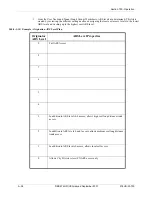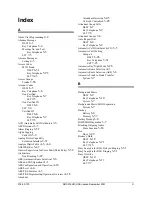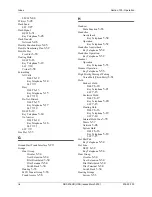
A-32
DBS 576HD (USA) issued September 2001
576HD-50-700
Section 700 - Operation
8. Each Route List Pattern consists of a one or more trunk groups in sequence to check for an available trunk.
Before a route is considered, the required ARS level is compared to the originator’s ARS level. If the
originator’s ARS level is greater than or equal to the required ARS level, the trunk group listed for the
route will be searched for an available trunk. If no trunk is found, the system will attempt to use the next
priority route.
In this example for Pattern 1, the system will first compare the Priority 1 ARS level for the call. If it is
determined that the ARS level is acceptable, the system looks at the route # 4 (FX trunk group). If there is
an available trunk, the system completes the call. If no FX trunk is available during the queuing time, the
system checks the ARS level for Priority 2. If acceptable, since Queuing Point is enabled the system will
first attempt to find an available Priority 1 trunk, and then attempt to find a Priority 2 toll-free trunk. If a
Priority 2 trunk is found, the system will first check to see if Warning Tone is set to Yes. In this example,
there is no warning tone. If Yes, the system would issue a warning tone to the user before connecting the
trunk to allow the caller to hang up before using the higher cost trunk. This process is repeated if necessary
for the Priority 3 - Long Distance Carrier B and then Priority 4 - Long Distance Carrier A.
Table A-16. Example - Route List Table
Route List Table
Route List
Pattern
Number
(1-500)
Priority 1
Priority 2
Priority 3
Priority 4
Priority 5
Rou
te
#
AR
S Lev
el
Rou
te
#
AR
S Lev
el
W
ar
ni
ng
T
one
Rou
te
T
abl
e
AR
S Lev
el
W
ar
ni
ng
T
one
Rou
te
#
AR
S Lev
el
W
ar
ni
ng
T
one
Rou
te
#
AR
S Lev
el
W
ar
ni
ng
T
one
1
4
FX
1
5
Toll-
Free
2
NO
3
Night
3
NO
2
Day
3
No
2
4
FX
1
5
Toll-
Free
2
NO
2
Day
3
NO
3
Night
3
5
Toll-
Free
2
3
Night
3
NO
2
Day
3
NO
4
5
Toll-
Free
2
2
Day
3
NO
3
Night
3
NO
5
3
Night
2
2
Day
3
NO
5
2
Day
2
3
Night
3
NO
















































